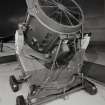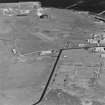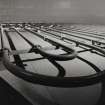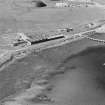Hoy, Lyness, Royal Naval Oil Terminal
Oil Storage Tank(S) (Second World War), Oil Storage Tank(S) (First World War)
Site Name Hoy, Lyness, Royal Naval Oil Terminal
Classification Oil Storage Tank(S) (Second World War), Oil Storage Tank(S) (First World War)
Alternative Name(s) Scapa Flow
Canmore ID 98128
Site Number ND39SW 20.02
NGR ND 30904 94633
Datum OSGB36 - NGR
Permalink http://canmore.org.uk/site/98128
- Council Orkney Islands
- Parish Walls And Flotta
- Former Region Orkney Islands Area
- Former District Orkney
- Former County Orkney
ND39SW 20.02 30904 94633
Formerly Site no. 19.01
One circular steel oil tank has been retained for display purposes 77m W of the Pumphouse/Museum (ND39SW 20.01).
The tank was one of sixteen which formerly stood in the area to the W and N of the Museum. All the tanks stood within earth banks, of which some can still be seen around the remaining tank.
Visited by RCAHMS (DE, GS, SW), August 1997
Field Visit (August 1997)
Lyness served as the centre for naval operations throughout WWI & II. The sheltered harbour offered an ideal location for refuelling and maintaining the fleet. The extensive remains of a wide range of structures associated with the base include:
(i) A boiler, a building, oil tanks, a military camp and a pillbox (ND 39 SW 20.01 -20.05).
(ii) Lyness steam pumping station and oil tank: Scheduled (HS Index 5438, 07ND 309 947- 07ND 310 947). The steam pumps were used to drive fuel oil into storage tanks. Originally coal-powered, they were converted to oil-firing in 1936. They now form a display within the Lyness Interpretation Centre. The oil tank, built in 1917, has a capacity of 12,000 tons and is the last survivor of four such tanks originally housed here.
(iii) A hand crane and pier (ND39SW 17)
Moore and Wilson, 1997
Coastal Zone Assessment Survey
Publication Account (2007)
Underground Oil Tanks, Lyness Base, Orkney, (East entrance)
(Institute Civil Engineers Historic Engineering Works no. HEW 1813)
The sheltered sounds around the islands of Flotta, Fara, Cava and Rysa Little made up the Royal Navy’s main fleet anchorage in Scapa Flow during both world wars. Close to these sounds, at Lyness on Hoy, an oil depot, naval quarters and stores were established during World War I and were considerably developed in the second war to form the Scapa Flow Naval Base Headquarters, temporary wartime home to thousands of military and civilian personnel. Lyness was finally closed as a naval base in 1957, when it was cleared of many of its wartime buildings, but continued to function as an Admiralty oil fuel depot until 1977.
Conspicuous among surviving structures near the modern ferry terminal is a solitary oil storage tank and pumping station (ND 310946), which together now serve as the Scapa Flow Visitor Centre. This tank, which had a capacity of 12 000 tons, was one of four erected in 1917 when oil-fired warships were coming into service with the Royal Navy. The associated pumping station, also built in 1917, housed the steam pumps which drew the heavy fuel oil from tankers at the pier. Originally coalfired, the pumps were converted to diesel power in 1936 when, with the threat of another war looming, plans were laid to massively increase oil-storage capacity. In 1937, Messrs Balfour Beatty & Co. Ltd were contracted to build 12 slightly larger 15 000 ton tanks, bringing the total complement of above-ground tanks to 16 by 1938. Also in 1937 the considerable engineering challenge of creating underground tanks – safer from potential aerial attack – went to Sir William Arrol & Co. Ltd.
The site surveyed for this purpose in 1936 lay beneath the summit of the nearby hill of Wee Fea, some 6100 ft west of the Lyness pumping station and at an altitude of about 295 ft above sea level. An additional pumping station to serve these tanks was designed by Arrol in 1937 and, complete with all its equipment, still stands halfway up the hill at ND 300942. Excavation for the tanks began in 1938, and construction work continued through to 1943
when six tanks had been completed and further work was aborted. The excavated spoil was tipped at the Lyness foreshore, creating an extension to the quay which, on account of the enormous cost involved (probably about £10 million overall), was ironically nicknamed ‘The Golden Wharf ’.
The subterranean tanks were arranged in parallel on a roughly north-eastern–south-western alignment beneath Wee Fea. On the northern and southern flanks of the hill, at ND 291946 and ND 285938, respectively, there are two entrances to the complex, some 3200 ft apart. Each entrance leads into an access tunnel of vaulted concrete construction, 10 ft wide and over 1200 ft in length. Within, a tunnel branches at right-angles across the ends of the six tanks which are encased in concrete, each of the six tanks measuring about 778 ft long, 45 ft wide and 48 ft deep. Together, they were capable of storing some 100 000 tons of oil. Filter tanks stand close to the entrance to the north tunnel, through which both the inlet and the outlet pipes passed, the south tunnel evidently being used principally for maintenance purposes. Fragments of the associated pipelines are still visible on the lower slopes of the hill.
Information from Geoffrey Stell.
R Paxton and J Shipway, 2007.
Reproduced from 'Civil Engineering heritage: Scotland - Highlands and Islands' with kind permission from Thomas Telford Publishers.
Project (March 2013 - September 2013)
A project to characterise the quantity and quality of the Scottish resource of known surviving remains of the First World War. Carried out in partnership between Historic Scotland and RCAHMS.




















